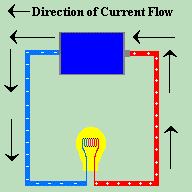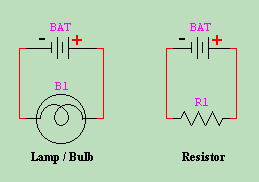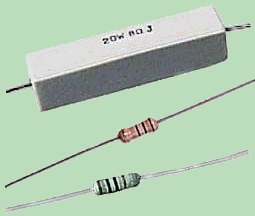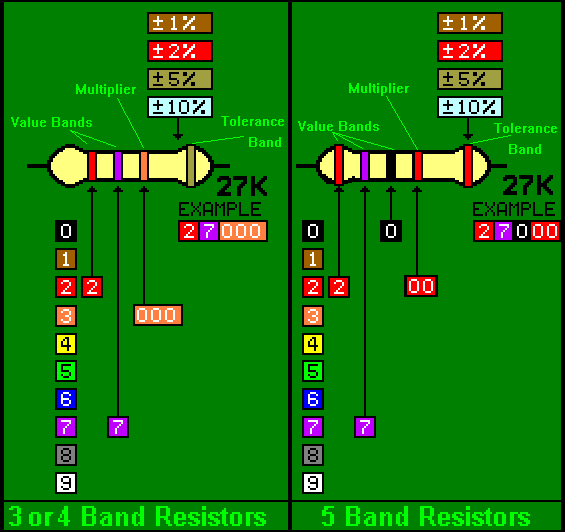


Schematic SymbolsSometime over the years, some bright soul determined that it would be difficult to draw a picture of every component that you decided to put into a circuit. However, they needed a way to tell their colleagues about discoveries and accomplishments. So a system was developed that was a sort of "electrical shorthand". They call it a SCHEMATIC DIAGRAM and the individual component representations are called SCHEMATIC SYMBOLS . Throughout the course, I will be introducing you to the various SCHEMATIC SYMBOLS one by one. This lesson will take you through the first two symbols, and describe how they are used in a circuit. The first three SCHEMATIC SYMBOLS you will be introduced to are the lamp, battery and resistor. 

You will notice that the picture on the left is the same one we just looked at. The one on the right actually has two schematic diagrams. The schematic on the left is an exact representation of the picture on the left. The schematic on the right we say is an ELECTRICAL EQUIVILANT circuit for the one on the left. Any circuit, no matter how complex, can be broken down to being a source and a load. The resistor represents the light bulb, which is the load of the circuit. Anytime you are having a problem figuring out how a circuit works, it can be helpful to break it down to an ELECTRICAL EQUIVILANT circuit. The SCHEMATIC SYMBOL for the light bulb is pretty self explanatory. The Schematic for the resistor looks like a series of sharp turns. Just remember that on a road, you have to slow down at sharp turns, and electrical flow (current) has to slow down at a resistor. The battery needs a little explanation. The lines represent the electrodes of a battery. Note that the SHORT line is always the NEGATIVE terminal, and the longer line is always the POSITIVE terminal.  Also along the way, I will try to give you an idea of what certain types
of
electronic components look like, although there are so many shapes
out there, I
can not possibly cover them all.
Also along the way, I will try to give you an idea of what certain types
of
electronic components look like, although there are so many shapes
out there, I
can not possibly cover them all.
I am fairly certain you already know what a battery and a light bulb look like, but you may never have seen a resistor. There are many types of resistors, but some of the most common types are shown in the picture to the left. The top one is a ceramic coated " wirewound ", which, as its name implies, consists of a winding of wire, cut to a certain length to create a certain amount of resistance. The second is a carbon composite, and the third is a metal film or metal oxide, which has very tight resistance tolerances. Note that on wirewound resistors, the values are printed on the side, whereas the carbon and metal types have their values painted on as color coded bands around the resistor. EXTRA CREDITNot a required part of the course, but if you wish to pursue electronics, you should probably memorize the resistor color code. It will be used throughout your career.THE RESISTOR COLOR CODEMany resistors that are produced are very small. In addition, resistors can get extremely hot with use. So hot, in fact, that they will often burn off any small lettering that may be printed on them. For this reason, resistors have been made with colored bands painted onto them. These bands conform to a universal color code, which identifies the value and tolerance of the resistor. Each of the colors below, correspond to a particular number.For the purpose of memorization, I was taught a MNEMONIC to remember the colors and their related numbers. However, for reasons of political correctness, I can not teach you the same mnemonic. The mnemonic procedure, though, is still valid, so I will present you with a new - more politically correct one. If you memorize this phrase, you will never forget the resistor color code: If you remember this mnemonic, you will not only know the values of resistors on sight, but also their tolerances. Here's how it works: Using the above phrase, it will indicate the following numbers:
Resistors may have anywhere from 3 to 6 colored bands on them. As a rule, the first two bands are the "value bands", so the color directly corresponds to the value. In the example, we are using a 27,000 Ohm ( or 27K Ohm ) resistor. The first two colors are RED and PURPLE, indicating the numbers 2 and 7. This is where things get tricky. On the 3 an 4 band resistors, the third band, called the "MULTIPLIER" - in this case being Orange, indicates that the 27 is followed by THREE zeros ( 000 ). So in this case, we have 27 followed by 000 or a 27,000 Ohm resistor. If there are only 3 bands, then we are done. 2 Questions arise though:
 Very good questions. They are both answered at the same time. The "Ripe Golden Squash Now" portion of the mnemonic refers to the 4th band, which is known as the "TOLERANCE" band. It has a very important job. (Note that the LAST band is ALWAYS the Tolerance Band. It usually has a wider separation than the other bands have from each other ( it is farther away ). We as people, are not perfect. Because of this, we make imperfect products. No resister is perfect. They are, however, all close to the value listed on them, plus or minus a certain amount. The amount of difference between their actual value, and the value listed on them should always fall within a certain tolerance. That tolerance is listed on the resistor, and is also designated by a colored band. Ripe Golden Squash Now (RGSN) corresponds with Red, Gold, Silver, None - the order of resistor tolerances in ascending order. Red = 2%, Gold=5%, Silver=10%, and No Band (None) = 20%. Let's assume that you have a 1000 Ohm resistor. If it has a 10% tolerance, it can be off by 100 Ohms, and still be good (1000Ω +/- 100Ω). So it will be allowed to be anywhere from 1100 to 900 Ohms, and still be considered good. If a 1000 Ohm resistor has a SILVER tolerance band, and is only 920 Ohms, it is considered to be within tolerance, and is a good resistor. However, if a 1000 Ohm resistor has a GOLD or RED tolerance band, and is only 920 Ohms, it is OUT of acceptable tolerance, and is considered to be a bad resistor. Now in the second example, we also have a 27,000 Ohm resistor, but the color code scheme is a little different. We still have a RED and a PURPLE as our first two colors, indicating the number 27, but the third band, instead of being orange, is BLACK, indicating Zero. The FOURTH band is the multiplier, and being RED indicates 2 zeros. Here is how this resistor is read: 27 0 00, or 27,000. |
| (On The Following Indicator... PURPLE will indicate your current location) | ||||||||||||||||||||||||
| 1 | 2 | 3 | 4 | 5 | 6 | 7 | 8 | 9 | 10 | 11 | 12 | 13 | 14 | 15 | 16 | 17 | 18 | 19 | 20 | 21 | 22 | 23 | 24 | 25 |
| 26 | 27 | 28 | 29 | 30 | 31 | 32 | 33 | 34 | 35 | 36 | 37 | 38 | 39 | 40 | 41 | 42 | 43 | 44 | 45 | 46 | 47 | 48 | 49 | 50 |
| 51 | 52 | 53 | 54 | 55 | 56 | 57 | 58 | 59 | 60 | 61 | 62 | 63 | 64 | 65 | 66 | 67 | 68 | 69 | 70 | 71 | 72 | 73 | 74 | 75 |
| Otherwise - please click to visit an advertiser so they know you saw their ad! |
